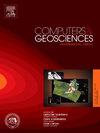Semi-analytical method for thermal field analysis of multiple arbitrarily shaped inhomogeneities in heterogeneous geological media
IF 4.4
2区 地球科学
Q1 COMPUTER SCIENCE, INTERDISCIPLINARY APPLICATIONS
引用次数: 0
Abstract
Natural geological formations typically exhibit heterogeneous thermal properties due to the presence of multiple inhomogeneities, such as mineral inclusions, fractures, or pore clusters, which significantly influence subsurface heat transport. In this work, an effective semi-analytical approach is proposed to investigate the heterogeneous thermal field containing multiple inhomogeneities with arbitrary shapes and various conductivities. Temperature solutions for rectangular elements are constructed from integrated line element temperatures, from which temperature gradients and heat flux are analytically derived. The work features a unified formulation for both the interior and exterior thermal responses of inhomogeneities, avoiding separate treatment of field regions. By Combing the Numerical Equivalent Inclusion Method (NEIM) with two-dimensional Fast Fourier Transform (2D-FFT) algorithms, the proposed approach efficiently solves thermal fields involving both stiff and soft inhomogeneities in heterogeneous media. Furthermore, the method is applied to geostructures, analyzing the thermal distributions of multiple arbitrarily shaped inhomogeneities subjected to remote heat flux. The semi-analytical method demonstrates high accuracy, computational efficiency, and robustness, providing a valuable tool for geoscientific thermal studies.
非均质地质介质中多个任意形状非均质热场分析的半解析方法
由于矿物包裹体、裂缝或孔隙团簇等多种不均匀性的存在,自然地质构造通常表现出非均匀的热性质,这些不均匀性会显著影响地下热传输。在这项工作中,提出了一种有效的半解析方法来研究具有任意形状和各种电导率的多种非均匀性的非均质热场。矩形单元的温度解由积分线元温度构造,并由此解析导出温度梯度和热流密度。这项工作的特点是对不均匀性的内部和外部热响应采用统一的公式,避免了对场区域的单独处理。该方法将数值等效包含法(NEIM)与二维快速傅立叶变换(2D-FFT)算法相结合,有效地求解了非均质介质中软硬两种非均匀性的热场。此外,将该方法应用于土工结构,分析了多个任意形状非均匀体在远端热通量作用下的热分布。半解析方法具有较高的精度、计算效率和鲁棒性,为地学热研究提供了一种有价值的工具。
本文章由计算机程序翻译,如有差异,请以英文原文为准。
求助全文
约1分钟内获得全文
求助全文
来源期刊

Computers & Geosciences
地学-地球科学综合
CiteScore
9.30
自引率
6.80%
发文量
164
审稿时长
3.4 months
期刊介绍:
Computers & Geosciences publishes high impact, original research at the interface between Computer Sciences and Geosciences. Publications should apply modern computer science paradigms, whether computational or informatics-based, to address problems in the geosciences.
 求助内容:
求助内容: 应助结果提醒方式:
应助结果提醒方式:


